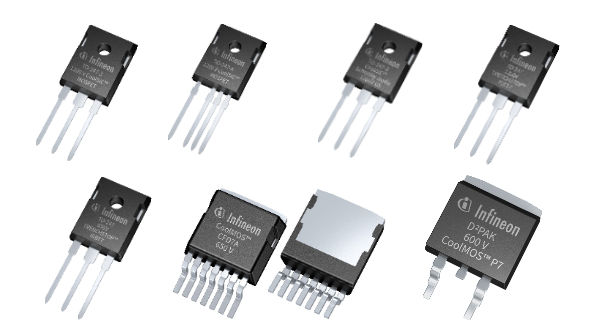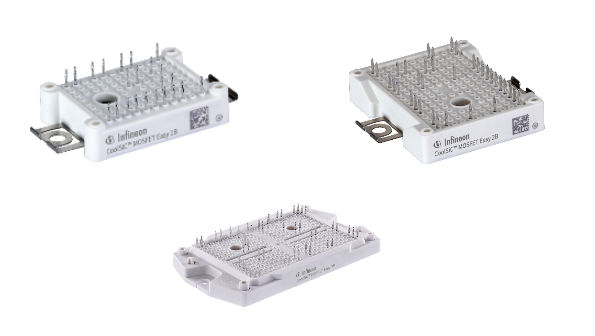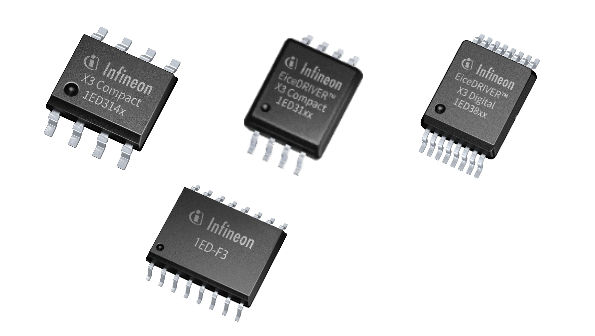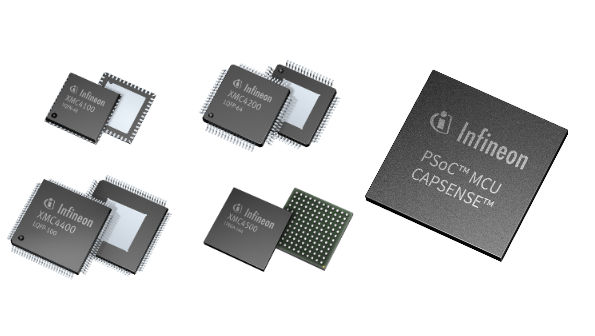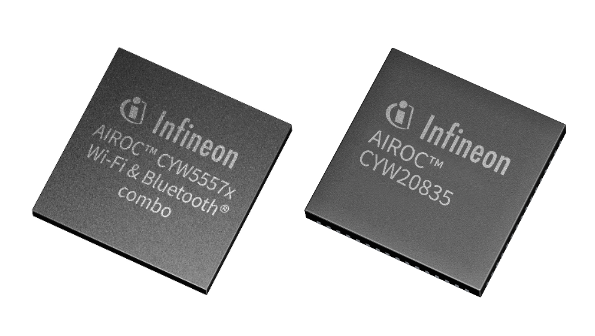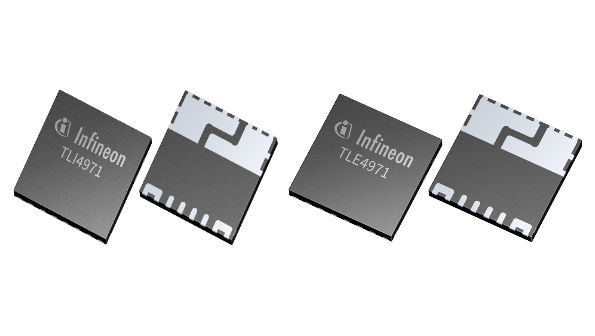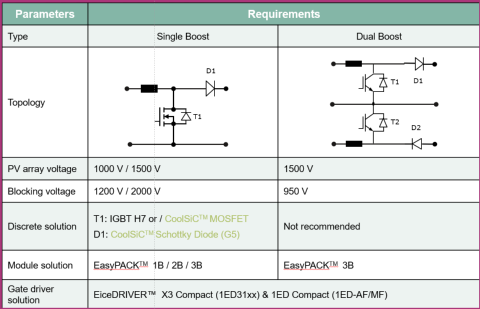3-phase string inverter solutions

Three-phase string inverters perform power conversion on series-connected photovoltaic panels. Usually, these inverters are rated around a few kilowatts up to 350 kilowatts. In general, most inverter designs are transformerless or non-isolated. String inverters typically rely on two-stage power conversion.
First, the DC-DC stage converts variable DC voltage into a suitable or fixed voltage required by the DC-AC inverter stage. At the same time, it ensures maximum power, which has been extracted from the PV string via MPPT (Maximum Power Point Tracking) technique.
Second, the DC-AC stage converts DC power into grid-compatible AC power. Either 2-level or 3-level topology is preferred in this stage. In particular, 3-level topology is widely used for its higher efficiency. Mainly for 1000 V PV array system, 3 Level NPC1 / NPC2 is preferred. 3 Level NPC1 enables to use of 650 V devices and allows more than 20 kHz switching frequency operation even for oversized PV panels. 3-level NPC2 uses 650 V and 1200 V devices, the best-fit topology for less than 20 kHz switching frequency operation. For the 1500 V PV system, 3 Level ANPC and NPC1 is widely used for their higher robustness against cosmic ray, and in particular, ANPC topology is widely used due to its higher efficiency over the full range of power factor operation. The size and weight of the inverter depend highly on the DC & AC filter and cooling system. Therefore, higher switching operation is desirable to reduce the size and cost of the system.
Infineon offerings for designs up to 350 kW
Building a single inverter of 6 kW up to 350 kW and connecting them in parallel to reach power levels up to 20 MW is common.
Infineon offers a wide range of solutions for 3-phase string inverters. Usually, these inverters are rated from 6 kW up to 350 kW. For power up to 20 kW, Infineon’s discrete IGBTs, CoolSiC™ MOSFETs, and CoolSiCTM Schottky diodes are the preferred choice to achieve the best price-to-performance ratio.
In power ranges above 20 kW, the Easy module family of products is the best choice for customers looking for a flexible and scalable power module solution, such as CoolSiC™ Easy Modules, Easy Booster modules, and Easy 3-level modules. The flexible pin grid system is perfect for customizing the layout and pinout. In addition, it is a great choice for power density and ease of manufacturing.
All switches need a driver, and all drivers need to be controlled. We also offer the right EiceDRIVER™ gate driver and the XMC™ and PSoC™ microcontroller for your inverter design. Finally, each functional block needs a sensor and auxiliary power supply, so we offer CoolSET™ together with our 1.7kV CoolSiC™ MOSFET and the TLI4971 & TLE4971 current sensor. A smart combination to address connectivity is provided by the AIROC™ family, which offers Bluetooth and WiFi in a single device. OPTIGA™ products complete the portfolio and ensure data protection and security.

Choosing the right solution for your 3-phase inverter design results in a combination of sophisticated digital control technology with efficient power conversion architecture to achieve excellent solar power harvesting and reliability. There are several main topologies used in the power stages of 3-phase string inverters. All of these topologies can be equipped with a booster stage to achieve a wide input voltage range and the opportunity to implement the MPPT algorithm.
Find the right products for your design topology within Infineon’s industry-leading power portfolio:
Trends and requirements of 3-phase string inverters
- Generally, for residential and small commercial applications up to 30kW, the user generates and consumes electricity. Improved self-consumption and avoiding expensive load peaks are highly important to save up on the electricity bill. The hybrid inverter type is gaining popularity due to the improved self-consumption of solar power. Like string inverters, hybrid inverters can connect multiple photovoltaic panels and convert D-C to A-C. But, on top of that, hybrid inverters can also supply D-C currents directly to a battery or another energy storage system. This eliminates unnecessary power conversions, which saves energy.
- For large commercial and utility-scale installations, PV system voltage increased over time to help reduce the levelized cost of electricity (LCoE). Like in the past, from 1000 V to 1500 V, even higher voltage standards may emerge in the near future. Further DC/AC ratio or oversizing of PV power plants is becoming the clear trend.
- Lightweight string inverters are gaining popularity in these markets up to 20 MW. They enable great design flexibility and easy transportation and are also quickly and easily replaced by two persons with a few clicks.
- Based on our deep application know-how in solar and related industries, we can reduce learning cycles and provide fast customization through proven short-flow processes. In combination with the strength of Infineon’s 650 V, 1200 V & 2000 V CoolSiC™ MOSFET, and TRENCHSTOP™ IGBT7 enable our customers not only to reduce system and operational cost significantly but furthermore help to harness never before seen levels of efficiency and power density.
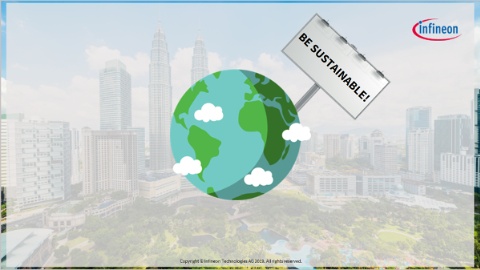
Let’s learn more about how solar inverters work, from the ones we have in our houses, to the ones that are applied in major factories. We will also see how Infineon innovates in power semiconductors for solar inverter technology and how that can help with reducing costs and time to market.

In this module, we will have a look at different solar inverter trends and how the technology is evolving.
And afterwards, we will see what Infineon’s comprehensive solutions for the positioning of solar applications are.
Solar Inverter for Photovoltaic (PV) Panels | Market, Application, Problem, Solution and System (E1)
The training overviews the different types of inverters and its functionality, it also positions products from Infineon for the specific inverter type with focus on control, connectivity and security. The training shows block diagrams of the difference solutions.
Webinars
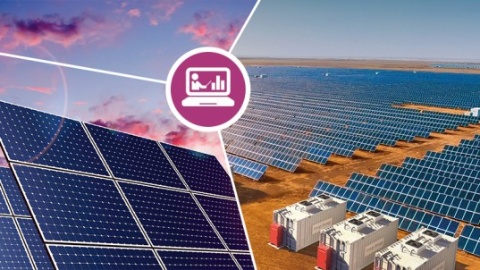
Join the webinar to learn about the positioning of SiC for in solar and energy storage applications. We will talk about the benefits of using Infineon’s Silicon Carbide MOSFET for solar and energy storage power conversion supported by real application examples.
In joining the webinar you will get a better understanding of the main technology trends in solar inverters.

